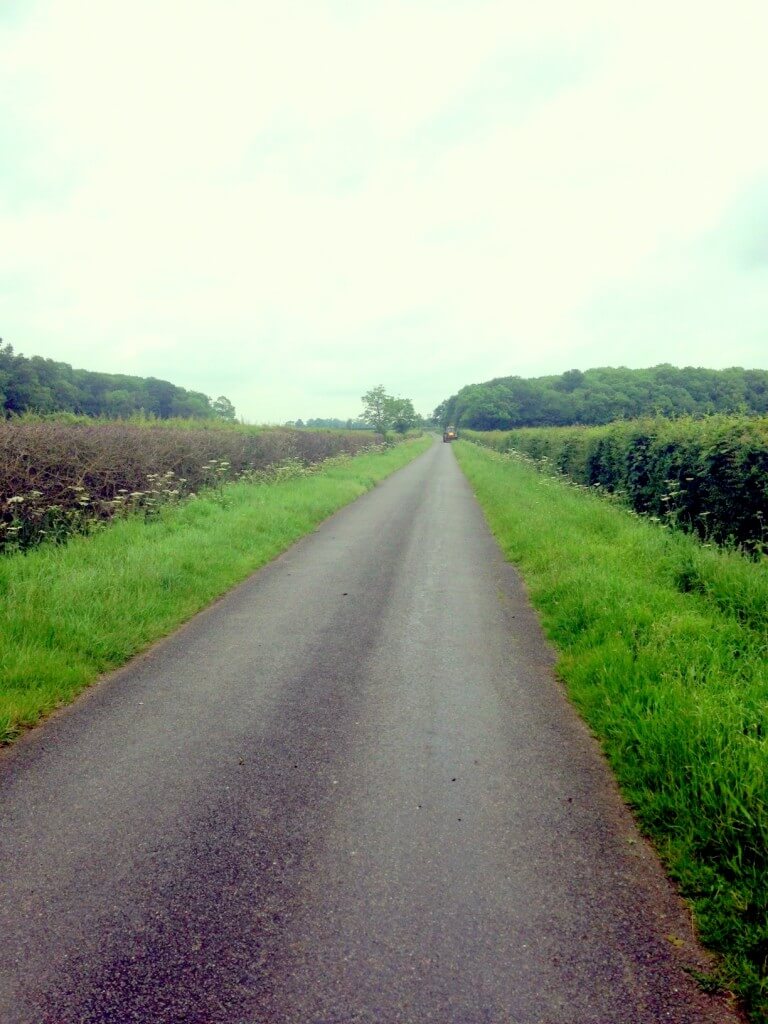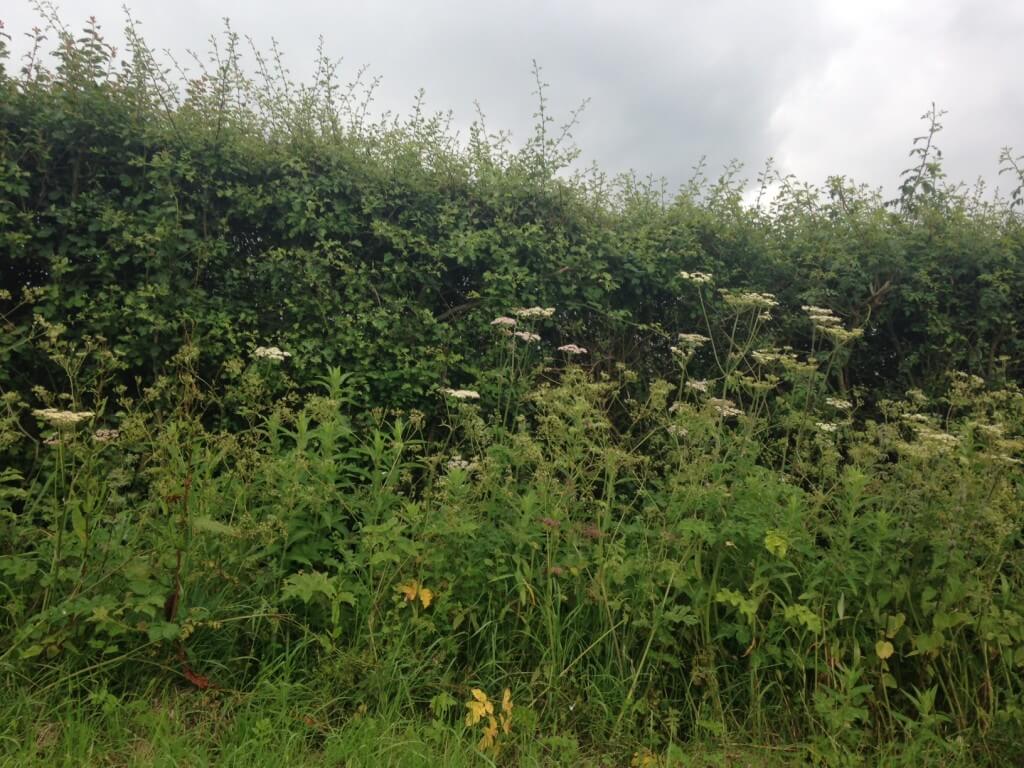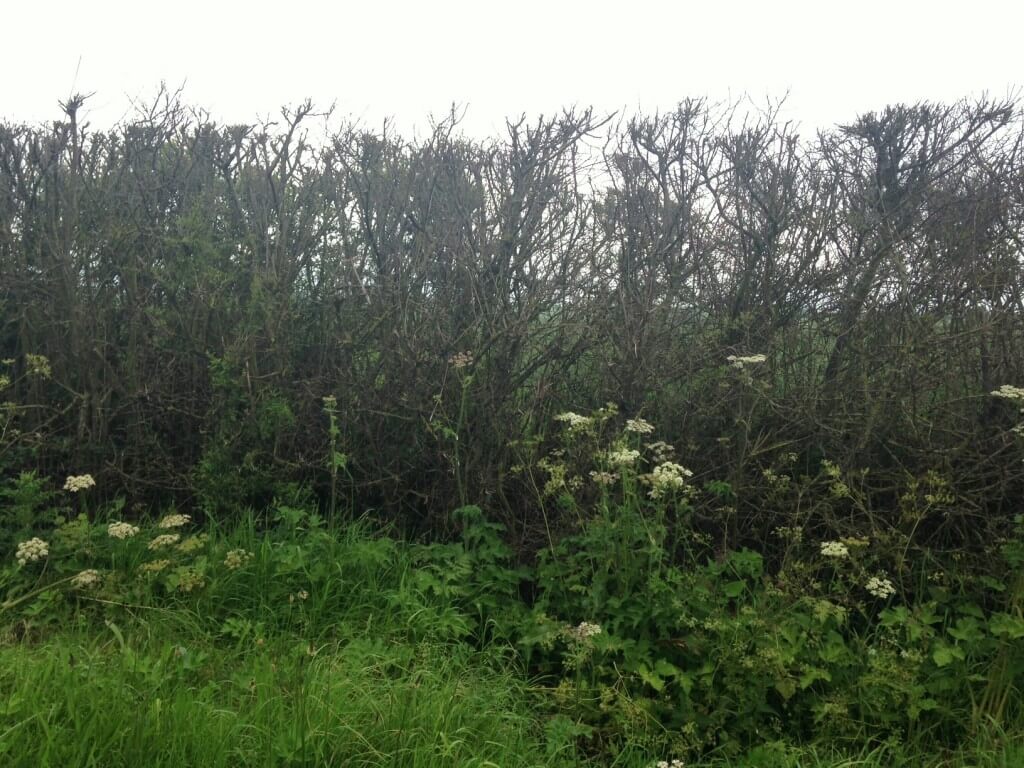I was driving down a country lane not far from home, a couple of months ago, when I noticed that the hedge on one side of the road was rather sparse; and then I noticed it was completely lifeless. I’ve never seen anything quite like it.
And it wasn’t just a few metres, it went on and on and on for, I reckon, over a mile.
I stopped and took a photo on the good side of the road…
…that looks pretty good, doesn’t it?
And then I took a photo on the other side of the road…
…and that looks pretty awful doesn’t it?
It is almost as though one side of the road was sprayed out, for a length of, as I say, and as I recall, over a mile. Incredible?
I did stop and mouthed at the man in the distant tractor in the top image ‘What happened there?’ but he shrugged and looked away, and I got the impression he wasn’t keen to talk.
Now, this is not a road I know well, but I talked to a few locals who said that they hadn’t noticed anything until this spring when one side of the road just never greened up. The local belief is that a contractor drove down the road with his spray still running after spraying an autumn wheat field with herbicide last autumn. Farmers I have spoken to think this would be very difficult to do by accident with modern day machinery. Nobody blames the farmer who actually owns most of this hedge and people say he is puzzled and upset too.
It’s a bit of a mystery. Anyone got any ideas?
Just in case you are wondering, locals tell me that the ‘bad’ side of the road now was, if anything, even better than the ‘good’ side of the road in previous years. I can’t corroborate that but I have checked this very spot on Google Maps, at street view (amazing what you can find on the web ain’t it?), and in June 2009 I can attest that the two sides of the road look equally luxuriant and species-rich. What a shame?
I wonder how long this long stretch of hedge will take to recover? Any ideas on that please?
[registration_form]


It would be odd if it was a spray because the verge is healthy enough. I am no expert in these things but I wonder if it is run-off into the ditch below. The hawthorn roots could have been deep enough to be affected but the roadside plants would mostly only have shallow roots.
This looks to me like a combination of 2 things – really poor flailing together with some root problems. Undermined by a plough possibly but I would rather guess at a flooding event – possibly ongoing (did you test the ground immediately below the hedge – it may have been really squelchy?)
In all fairness it may well be that the flailing took place after the hedge started to deteriorate in a botched attempt to reinvigorate it. Don’t scoff – it has been known to work.
Obviously in a disclaimer to any subsequent comments to analyse such simply by photos is very far from ideal and not recommended by any professional accreditation organisations or indeed or my own insurance.
I suspect it’s the larvae of one of the ermine micro moths. They can totally defoliate a long stretch of hedgerow very quickly. Tell take signs on closer inspection are the larval webs, caterpillars and droppings. Hedges will usually bounce back the following year.
There’s a formula for number of woody species per distance per century but I think that is partly related to the fact that later hedges were planted with single species whereas very old hedges are just taken from the woodland.
Surely not spray or all the verge would be dead too. How about one of the processionary moths?
That looks very strange. What strikes me is that the vegetation on the verge appears unaffected and I think the field side of the hedge has green on it. Is there a ditch between the hedge and the verge? Perhaps someone dumped some lethal toxins in the ditch and it has killed the hedge via its roots but not the grass verge.
I have seen exactly the same thing Mark, while walking in north Norfolk in late Spring this year. It was the field side of an arable field and I looked closely at it and surmised it was the effect of pesticide spray drift. No other hedges in the area were affected, and it was the whole hedge length. The outer side had lots of healthy growth. I believe it was done by error as the farm had various conservation headlands, margins etc.. It wasn’t salt/cold winds as all adjacent hedges were fine. I imagine it will take many years to recover.
I also think someone put some terrible liquid in the ditch.
Doubt spray drift would be anywhere near strong enough to bother a healthy hedge except maybe scorch the leaves on that side of the hedge but in spring the hedge would show no ill effects and even someone with a spray still running while on the road would be going fast enough to not get enough spray on the hedge to bother it and the verge would get killed first.
Not sure it will ever recover to be any sensible hedge if it is caused by something in the ditch.
Reckon it was herbicide spray drift from inside the field. If it was total weedkiller, i.e.Roundup 480, the hedge has had it more or less.
I would suggest what others have said is probably correct about definitely being some sort of chemical. I would think the people saying about nasty chemicals being dumped in the ditch are closest to the truth. If you look carefully at the photo you can see that there is some growth toward the top of the hedge, but almost none at the bottom of it.
That looks more likely than moths, given that the damage became evident only when the buds on the affected hedge failed to grow. I’d place 5p on a discarded container of chemical – not necessarily a pesticide container. Report it as pollution to the EA.
I’m sorry to disagree with everyone – but this is not pesticide damage! If pollutants are involved it has been a very large quantity applied directly to the roots. The damage is more severe than I have seen when a huge leakage of nitrate was dumped along the base of a similar hedge, which itself was surrounded by consolidated ground and therefore unable to drain away. I know everyone wants to blame the farmers and to this end you can in so far as the flailing is bad practice. And I am no advocate of pesticides – which in my opinion are the biggest threat to having a sustainable future due to the damage they do to soils.
The increasing desire to bash farmers and indeed any other land management practitioner only serves government who can easily conquer the divide this creates.
I am not sure anyone is pointing the finger at farmers or farming practises here Pip, Mark clearly states that he did not know what caused this and the farmer was equally in the dark. The theory was offered up about herbicide spraying but IMO does not seem likely, nor does flailing. A biological explanation is not impossible but i would have expected at least some damage on the other side of the road. The ditch pollution theory seems to fit best and I know in the Midlands region that this type of topography is common (we even have some on the mosses between Irlam and Astley) with ditches on either side of the road and not necessarily connected. It does not take much to cause extensive damage and Filbert could even be right about a discarded (deliberate or otherwise) container unconnected to any farming procedure.
Nothing wrong with flail hedge trimming done properly,Admittedly does not look good if it is done drastically but neither does any other form of hedge maintenance if done drastically.
Almost every farm hedge that looks good is trimmed with a flail hedge trimmer,have not seen anything else used on farm hedges for decades.
Quite so. Recent visitors – who used to be our next-door neighbours of half a mile away – commented on the overgrown hedges on our track. A quick recovery from the flailed to near-death condition in early April! It’s known to us Yellowhammer Alley, on the way to Woodcock Corner.
Don’t just concentrate on farms. Network Rail seem to have a policy on the Carlisle to Ulverston Rail track to blast every bush or other plant growing alongside the rail track with herbicide. What was a brilliant linear wildlife habitat is now just a cemetary of dead sticks !! They are even spraying across onto adjacent properties !
Is this Buddleia-hate in action?
Cannot see how this could have been done by a misdirected spray if the surrounded vegetation was not affected. There aren’t many sprays which would do this to the woody vegetation of a hedge. Adjacent fields can be affected by spray drift with the hedge in between unaffected, even with glyphosate. It must be something that has been directly applied to the hedge or its roots, or something biological.
“discarded”
Fly-tipping is a widely under-reported crime that MOTP* perpetrate for which the landowner takes the damage to property and pays the cost of clean-up
*March of the Pigs; Manual of the Planes; Mask of the Phantasm; Mobile One Time Password; Map Of The Problematique; Medical Officer Training Plan; Members of the Press; Multiple Object Tracking Precision; Members of the Project; Maintenance Officer Training Program; Middle of the Pack – in fact none of these, but Members of the Public